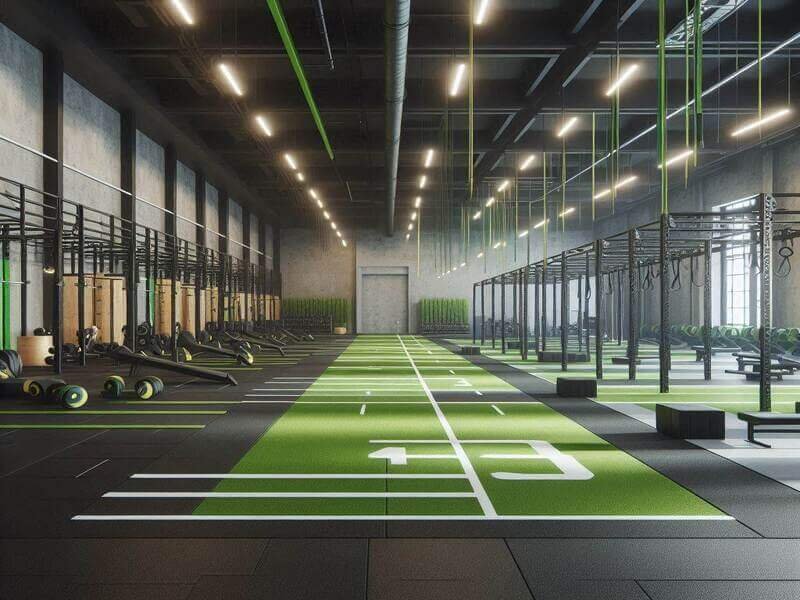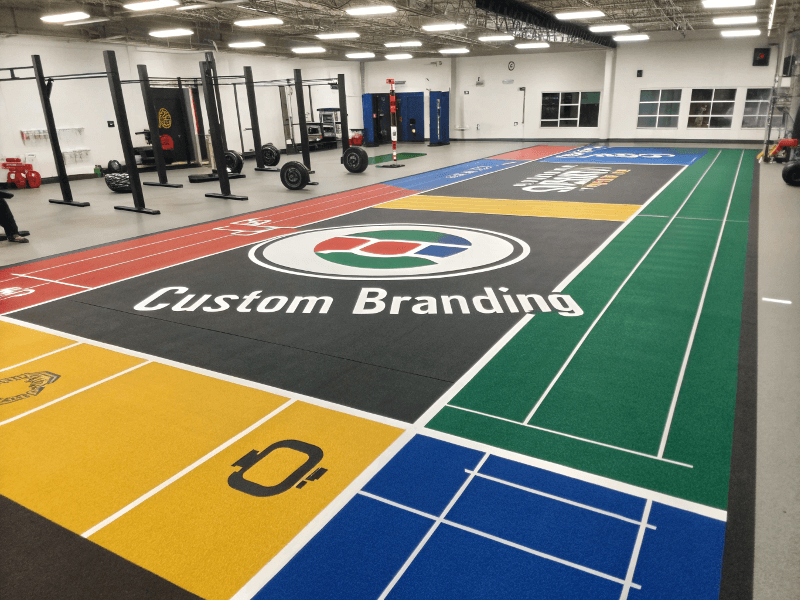The best OCR gym flooring is a strategic combination of materials. Use high-density, short-pile gym turf for agility and sled work, and thick (20-30mm) rubber tiles for free weight and high-impact zones. This mix ensures safety, durability, and peak performance for your members.
As a gym owner, I’ve learned that the ground beneath your members’ feet is the most critical piece of equipment you’ll ever buy. The Obstacle Course Racing (OCR) trend is booming. People want to train for events like Spartan Race and Tough Mudder year-round, and indoor facilities are the future. But your success hinges on the details. The first, and most important, detail is your flooring. It’s not just about looks. It dictates the safety of your members, the longevity of your equipment, and the overall professional feel of your space. A cheap floor can lead to injuries, constant repairs, and a bad reputation. A smart flooring investment is the foundation of a safe, durable, and profitable modern OCR gym. I built my business on this principle, and I’m here to show you how to do the same.

Choosing the right floor can feel overwhelming, but it doesn’t have to be. I’m going to walk you through the exact things you need to consider.
What Four Core Needs Must Your OCR Flooring Meet?
Your flooring must deliver on four key points: safety from slips and impacts, durability against heavy weights and high traffic, functionality for different training styles, and aesthetics that build your brand. Neglecting any of these can cost you money and members down the line.
When I opened my first facility, I was trying to save money and went with a thinner, all-purpose rubber roll. It was a huge mistake. We had issues with everything. That experience taught me to break down flooring needs into four simple, non-negotiable categories. Get these right, and you’re building on a solid foundation.
Safety First
This is where you never cut corners. Your members need grip for sprints and agility drills. They need shock absorption for box jumps and rope climbs to protect their joints. I saw a huge drop in minor sprains after upgrading my floor. And for ground-based movements like burpees or bear crawls, you need a surface that won’t cause skin burns, like cheap carpet-style turf can.
Durability
Your floor will take a beating. Barbells will be dropped. Sleds loaded with hundreds of pounds will be pushed and pulled across it daily. High-traffic lanes will see thousands of footsteps. You need materials built for this abuse. A floor that dents, tears, or wears out in a year is not an asset; it’s a liability. Your floor also needs to be easy to clean to handle sweat, chalk, and dirt, keeping your gym hygienic and reducing your staff’s workload.
Functionality
A great OCR gym has different zones, and each zone needs a different type of performance from the floor. Some areas need to be firm with good energy return for explosive movements. Other areas need to be soft to absorb maximum impact. Using different materials to create these zones is key. It helps guide members through their workouts and allows you to run multiple types of classes at once without compromise.
Aesthetics & Branding
Never underestimate first impressions. When a potential member walks in, the floor is one of the first things they see. A clean, professional, and visually striking floor screams quality. This is also your biggest canvas. You can embed your logo right into the floor at the entrance. You can use different colors to define workout zones. A great-looking floor helps justify premium membership fees and makes your members proud to train there.

Now that you know what to look for, let’s get specific about what to put where.
How Do You Choose the Right Flooring for Each Gym Zone?
You create a "golden combination" of flooring. Use specific materials for each zone based on the activity. This ensures you are not using a one-size-fits-all approach that fails to meet the unique demands of each training area in a modern OCR facility.
Here is a simple breakdown I use when planning a gym layout. It’s a system that has never failed me.
| Zone | Recommended Material | Key Purpose |
|---|---|---|
| Agility & Sleds | Gym Turf | Durability & Low Friction |
| Free Weights | Thick Rubber Tiles (25mm+) | Impact & Sound Absorption |
| Sprint Tracks | Custom Turf or Rubber Rolls | Grip & Energy Return |
| High-Impact/Rigs | Extra-Thick Rubber (30mm+) | Maximum Safety & Shock Absorption |
| Reception & Lounge | Luxury Vinyl Tile (LVT) | Aesthetics & Easy Cleaning |
This table is your starting point. My first gym had rubber everywhere, and sled pushes were a nightmare. The friction was too high. When I built my second gym, I created dedicated turf lanes, and it completely changed the game. Members could push sleds smoothly, and it instantly made the facility feel more professional and specialized. Let’s break down each zone.
Functional & Agility Zone
This is where you’ll do sled pushes, battle ropes, tire flips, and agility ladder drills. The perfect material here is a short-pile, high-density gym turf. It’s incredibly durable and has just the right amount of slip for sleds, but enough grip for footwork. Plus, the soft fibers prevent the nasty skin burn you can get from doing burpees on other surfaces.
Free Weight & Heavy Equipment Zone
This is your powerlifting area with squat racks, deadlift platforms, and dumbbells. You need high-density rubber tiles. The key here is thickness. For general dumbbell areas, 15-20mm (about 3/4 inch) is fine. But for your dedicated deadlift platforms and squat racks where heavy weight will be dropped, you must use 25-30mm (1 inch or more). This protects your subfloor, your equipment, and drastically reduces noise.
Sprint Tracks & Running Lanes
For dedicated running lanes, you can use custom gym turf with lines embedded directly into it. It looks amazing and provides excellent grip. Another option is a high-quality rolled rubber, which provides great energy return for sprinting and plyometrics.
Buffer Zone Under Rigs
For any area where members will be coming off a rig, a climbing wall, or high box, safety is everything. I recommend using your thickest rubber tiles here (30mm+) or even a dual-layer system with a shock pad underneath the rubber. This is an area where you want maximum impact absorption to prevent injuries from falls.
Reception & Lounge Area
Don’t forget the entrance. This area needs to look sharp and be easy to clean. A commercial-grade Luxury Vinyl Tile (LVT) is a fantastic choice. It comes in great-looking wood or stone finishes and can handle heavy foot traffic. It sets a professional tone the moment someone walks in the door.

Your floor is more than a surface. It’s a tool to make your business better.
How Can Your Floor Design Boost Your Brand and Member Experience?
Your floor is your gym’s biggest billboard. Use custom colors, lines, and logos to create a visually stunning environment that guides workouts, reinforces your brand, and makes your facility look more professional. A smart design makes your gym more intuitive and impressive.
Think of your floor as a silent instructor and a powerful marketing tool. When I first started, my gym floor was just plain black rubber. It worked, but it was boring. For my next facility, I invested in custom design, and the difference was night and day. New members were instantly impressed, and it made running group classes much easier. The floor itself became a part of our brand identity. It’s not just about looking good; it’s about creating a smarter, more effective training environment that people want to be a part of.
A Navigation System on the Ground
You can use design to direct the flow of your gym. Use different colors of turf or rubber to create obvious zones for different activities. For example, a green turf lane for sleds, a black rubber zone for lifting, and a grey area for stretching. You can add lines for sprint tracks or agility ladders directly into the floor. This creates an organized, easy-to-understand layout that helps members know exactly where to go and what to do. It reduces confusion and makes the space feel larger and more structured.
A Floor That Speaks for Your Brand
This is where you can really stand out. Putting your gym’s logo in the middle of the training floor or at the entrance makes a powerful statement. It builds brand pride and looks amazing in photos that members share on social media, which is free marketing for you. You can also add custom functional markers. I had numbers, distance markers, and agility dots put into my turf lanes. This was a game-changer for coaching classes. I could just call out "everyone to dot number five" instead of trying to herd people around. It makes training more efficient and interactive. A floor with these custom touches tells your members that you are a serious, professional facility that has thought through every detail of their experience.

Thinking about the cost is important. But you need to think about it as an investment, not an expense.
Is Quality Gym Flooring a Smart Financial Investment?
Yes, absolutely. High-quality flooring is a one-time investment that pays for itself over and over. It prevents costly subfloor repairs, reduces the risk of member injuries and potential liability, and lasts for years. Cheap flooring is an ongoing expense that will cost you more in the long run.
I track every dollar in my business, and I can tell you from experience that spending more upfront on the right flooring is one of the smartest financial decisions a gym owner can make. The initial price tag on cheap flooring looks tempting, especially when you have a hundred other startup costs. But it’s a trap. That cheap floor will cost you far more in repairs, replacements, and even lost members than a quality floor ever will. Think about the total cost of ownership over five or more years, not just the initial purchase price.
The Real Cost of "Saving Money"
Let’s do some simple math. A cheap floor might save you a few thousand dollars today. But within a year, it will likely start to tear in the sled lanes and get damaged in the weightlifting areas. So now you have to patch it, which looks terrible, or replace entire sections. Do that a few times, and you’ve already spent what you would have on a quality floor. Even worse, what if a member slips on a worn-out spot or drops a weight that goes right through a thin mat and cracks the concrete subfloor? Now you’re looking at a potential lawsuit or a massive repair bill. Quality flooring, like thick rubber and dense turf, is designed to absorb these impacts for years. You buy it once, and you’re done.
The Value of a One-Stop Solution
As a business owner, your time is your most valuable asset. The process of picking flooring, finding a designer, getting it shipped, and hiring an installer can be a huge headache. This is why I now only work with suppliers that offer a one-stop solution. I tell them my vision, and they help me with everything. They provide free 2D and 3D drawings so I can see exactly what it will look like. They handle the custom production and the complex logistics of shipping heavy materials. They even provide detailed installation guides. This saves me dozens of hours of work and prevents costly mistakes. It lets me focus on running my business, not on managing a construction project. This streamlined process is a huge value and a key part of making a smart investment.
Conclusion
Choosing the right OCR gym flooring is a foundational business decision. Prioritize a combination of gym turf and thick rubber to ensure safety, durability, and a great member experience.

![小红书6.13WechatIMG6523 11[1]](https://meettfit.com/wp-content/uploads/2025/06/小红书6.13WechatIMG6523_111.jpg)